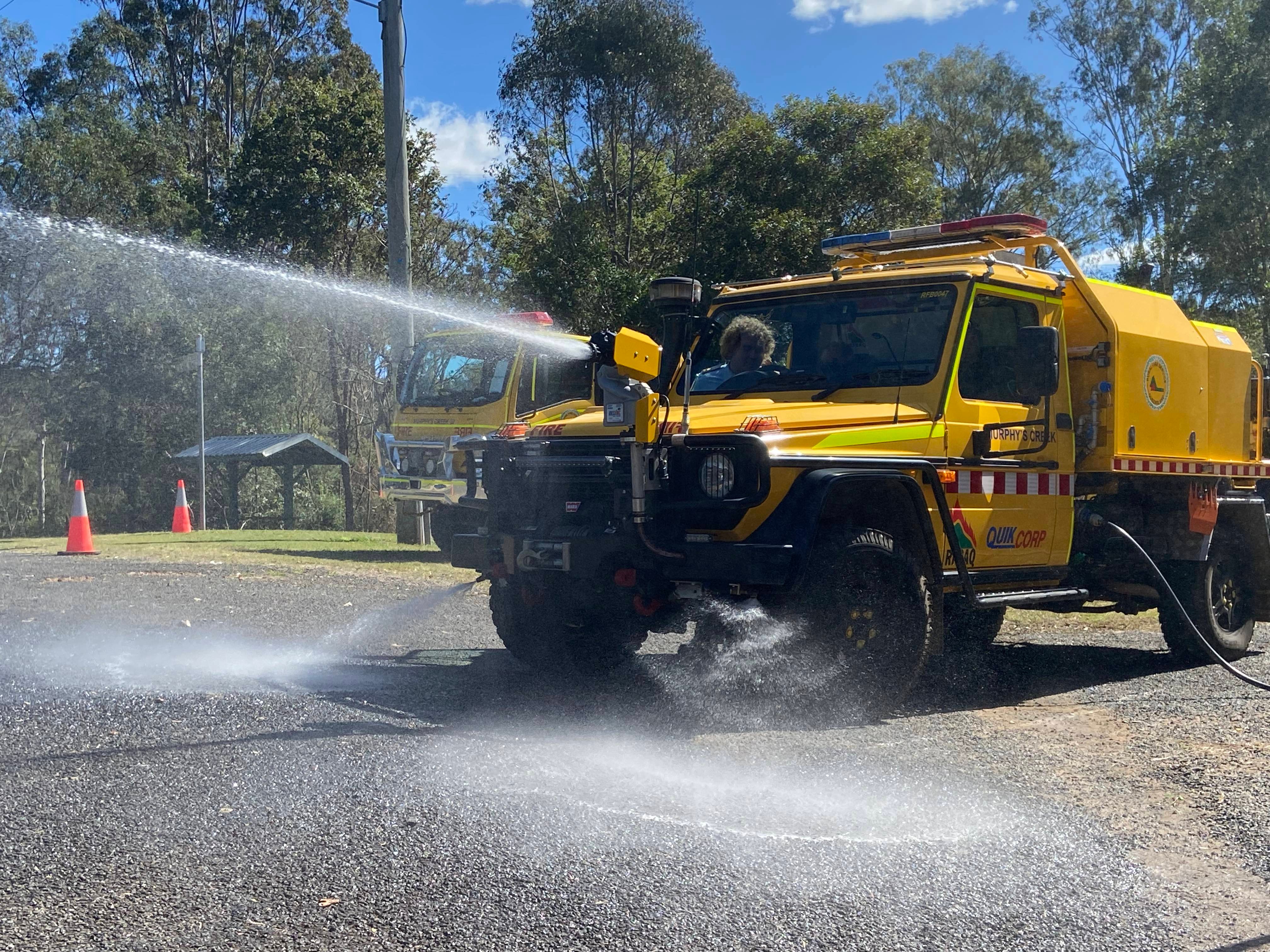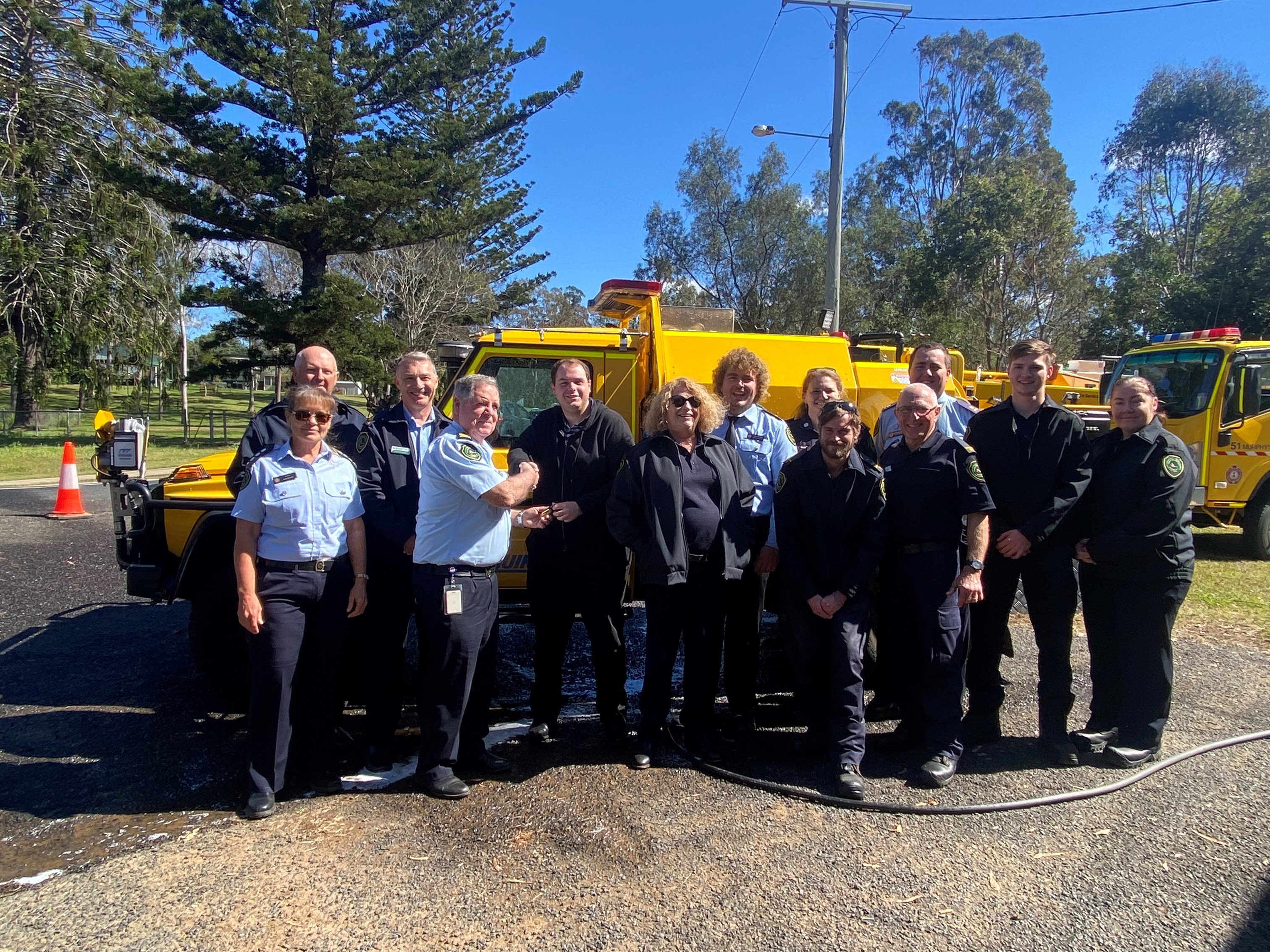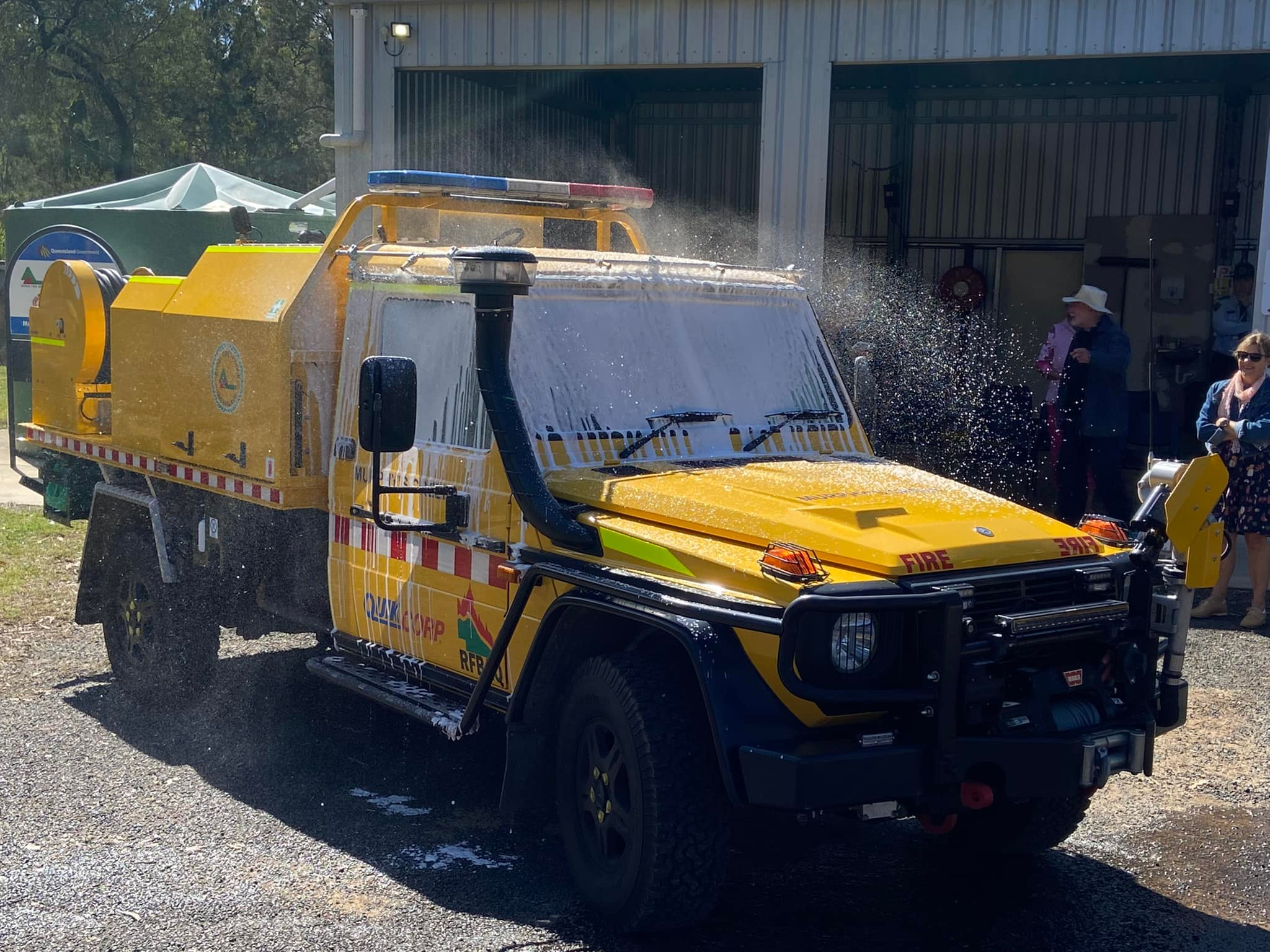Innovation Platform
The Innovation Platform becomes Murphys Creek 41
Monday, 8 Aug 2022
Congratulations to Murphys Creek Rural Fire Brigade who received the RFBAQ / QuikCorp Innovation Platform on Sunday.
The vehicle was kindly donated to the RFBAQ by MercedesBenz Australia and was a test bed for the latest in crew safety ideas and inventions to make the dangerous art of firefighting safer for the firefighters.
A flow-on benefit of this donation by the RFBAQ and QuikCorp is that the former Murphys Creek 41 will be cascaded to Pinelands RFB which currently is one of the 60% of Rural Fire Brigade in Queensland that do not have a fire truck. Pinelands brigade is located on the New England Highway between Crows Nest and Cooyar.
The RFBAQ would again sincerely like to thank Mercedes-Benz Australia for donating the cab chassis and to the Dowling Family Foundation who made a very generous donation to the RFBAQ to help cover the cost of equipment, fit-out, registration and insurance.
The RFBAQ / Quikcorp Innovation Platform team would also like to thank the sponsors who have whole-heartedly backed this process from inception and who are all invested in trying to give firefighters a safer vehicle to work from and retreat to.
We hope that this vehicle serves the local community well for the next 20 years.
This is the 11th fire truck that the RFBAQ has given to Rural Fire Brigades in Queensland over the last 2 years.


Neutral Operating Position
Tuesday, 10 Aug 2021
In our wanders across Queensland with the Innovation Platform talking to brigade members about crew safety we have developed the Neutral Operating Position.
60% of brigades in the state do not have a fire truck. These landholders primarily use slip on units and trailers coupled with their own utes to meet their community defence needs and some of these brigades are the ones that are transitioning into truck brigades.
These landholders live in areas of low population density and have been calling for a vehicle that can be operated by either driver or passenger.
The RFBAQ has developed a 550lt belly tank Landcruiser based on brigade needs and to date the RFBAQ has given 8 of these Light Attacks to brigades without trucks.
This desire for ease of operation by limited crew is overlayed with the RFBAQ QuikCorp Innovation Platform creating a safer place inside the cab of the vehicle.
Please have a look at the YouTube piece and understand the reasoning behind the changes to layouts and our desire to create a design that meets the needs of the brigades.
A huge thanks to GAAM and TFT (Task Force Tips) for the amazing bit of kit.
First fire truck in Australia fitted with Sentinel 300 air purifier
Friday, 23 Apr 2021
This Sentinel 300 has been specifically designed to fit in the Isuzu dual cabs that are in Queensland.
An enormous thanks to Semperfire for making the unit to meet the identified need and then donating it to the brigade and another huge thanks to QuikCorp for fitting the device and managing the 12 month assessment process to evaluate the trial.
By adding this air purifier we are trying to achieve two goals:
- The removal of particulates out of the air within the cab, this will make a safer place for firefighters on the fireground and reduce exposure to cancer causing materials (Firefighters are more likely to contact 12 different types of cancer than the general population*).
- As the fire service does not pay to have airconditioning fitted in the rear of dual cab appliances the rear space can become hot and fetid very quickly.
The desire is that the Sentinel 300 will distribute cool air from the front of the cab to the rear.
This lack of aircon in the dual cabs is a long standing issue that has not been addressed – here is a section from a Hazard Report (SHE) from 2015 and the brigade still has not received any response from the QFES regarding this matter.
The device runs when the engine is operating and there is also the ability to switch it off on the device.
The vehicle fitted with the Sentinel 300 can be identified by the green light on the top of the cab. This light is on when the beacons are activated. This will allow for quick identification of the fire ground of a cooler and safer place to put firefighters affected by heat stress or injury while waiting for medical attention.
RFBAQ Innovation Platform
The most important thing in our organisations are our people.
The most important thing that our people have is their health.
Firefighters contract 12 different types of cancer in significantly higher numbers than the general population.
On the fireground firefighters are exposed to all the fury of nature at its worst.
As firefighters, we choose to undertake activities that are dangerous and this Innovation Platform was created to ensure that more of us go home and fewer of us develop ongoing illnesses.
Full time, part time, volunteer; fire service, parkie, council, mines, forestry, commercial; smoke and heat doesn't discriminate. This conversation is for us all.
The RFBAQ / Quikcorp Innovation Platform is the catalyst for a conversation that will happen across Queensland over the next several months and will conclude at the RFSQ Volunteer Summits in Cairns and Mudjimba.
The platform itself has been donated by Mercedes Benz and at the end of this process the vehicle will be gifted to a brigade*. The Dowling Family Foundation made a very generous donation to the RFBAQ to help cover the cost of equipment, fit-out, registration and insurance.
The RFBAQ / Quikcorp Innovation Platform would also like to thank the sponsors who have whole heartedly backed this process from inception and who are all invested in trying to give firefighters a safer vehicle to work from and retreat to.
A special thanks to Deputy Commissioner Mike Wassing who not only jumped at the opportunity to be involved from day one in January, but who also provided support through RFSQ and QFES.
One of the almost impossible challenges is to carry everything that you want as well as water on a fire truck. Everything has weight and every time you add a new piece of equipment you must commensurately take something off or reduce something that you already carry. This conversation is then also about acceptable risk, and minimising risk while still achieving the primary function of a fire truck which is to put the wet stuff on the red stuff.
We hope that during this process, the Innovation Platform will evolve and change as manufacturers and innovators refine and redesign and that new ideas are brought to both the RFBAQ and QuikCorp.
Quikcorp Fire Engineering has supplied over 700 hours of labour, engineering expertise and materials free of charge to turn this concept into actuality.
- External and Internal Fire Curtains – Internal fire curtains are safer than no fire curtains, but still allow heat into the crew space. By fitting external curtains an air gap is formed that increases survivability. The external curtains can also be deployed individually to give added protection to the specific side of the vehicle being impacted when driving.
- Cab Protection Water / Foam Spray – A stand alone electric pump system activated from within the cab has a separate 40 ltr water tank to pump water through a solid block foam canister to foam the vehicles cab. This light weight innovation could for the first time bring crew protection sprays onto light attack fire trucks. In conjunction with the external fire curtains this will add to the barrier between the fire and firefighters but can also be deployed separately as a last resort defence.
- Internal Air Scrubber – Located in the cab, this system cleans the cabin air through a series of filters and provides a cleaner space by removing smoke and carcinogens.
- Thermal Imaging Camera – Located on the bullbar with the screen in the cabin, this camera allows both passenger and driver to identify fire or other operating vehicles through smoke. In last year's enormous fire season we saw fire vehicles drive into heavy smoke while on the road to escape the approaching fire front. This will give an added level of safety in that instance. The screen also links to a work deck camera and a reversing camera and these 3 views can be easily changed while driving.
- Ambient Heat Alarm – An addition to the vehicle telematics, this innovation sounds an alarm to firefighters on the fireground and shows an alarm on the vehicle for the incident controller. When wearing full PPC on the fireground you do not necessarily notice consistent changes in the ambient temperature. When ambient temperatures exceed 47 degrees celcius for a period of 3 minutes an alarm will sound to recall firefighters back to their vehicle. This alarm will also notify incident control if a number of these alarms are activated. This is a warning of changing weather on the fireground and a prompt to consider drawing crews back to a safer defensive line.
- Over-cab Deflection System – Falling branches and trees kill firefighters. How can we develop a system for a light attack vehicle that is available on the market that provides a level of protection and what level of protection are we willing to accept?
- 40 ltr Drip Torch Fuel Tank – At the rear of the vehicle this tank stops the need to carry and lift drip torch fuel drums, has a safer way of transferring the fuel into the drip torch and is located at the rear of the vehicle away from the crew space.
- Electric Chainsaw with Built-in Charger – This increases safety as the vehicle is now not carrying fuel drums for the chainsaw motor.
- Winch on Bullbar – Currently not available to brigades in Queensland, a winch increases safety by allowing the vehicle to clear a path to drive through. A winch also increases risk without safety and operation training.
- Fridge – Permanently fixed into the vehicle this new design fridge negates the need for fridge slides and drawing a fridge in and out to access the contents.
There are an additional number of improvements to the usability of the vehicle that was identified during the 6 x RFBAQ Landcruiser Prototype field tests and over 200 completed feedback forms from brigade members.
A huge thanks to all the sponsors of this project and the equipment that you supplied –
Thermaguard – fire curtains
Ionnic – water level indicators
Stratos – suspension seats
Code 3 - emergency lights and controller
Hatz – pump engine
Philcomm – UHF portables
RFSQ / QFES - departmental support and stowage
In the RFBAQ Constitution the Objects of the Association are –
- To consider and make representation in matters affecting the welfare and efficiency of Rural Fire Brigades and Brigade Members.
- To provide financial assistance and support to Rural Fire Brigades and their Brigade Members.
We believe that the Innovation Platform certainly meets these objectives.
* Bymount Rural Fire Brigade (who will receive the G-Wagon cascaded vehicle allocation) is a Primary Producer brigade in the Maranoa Regional Council area. The brigade has 47 firefighters and a total of 63 members. Current equipment is 6 mop-up units. The Bymount RFB sits adjacent to the Carnarvon Highway approximately 60km north of Roma and 30km south of Injune. The brigade has a large membership of active members who regularly respond to incidents in their own and neighbouring areas using the RFS supplied slip-on units. Over the years a number of fires have occurred along the Carnarvon Hwy, with increasing traffic, this occurrence of these types of incidents will continue to increase. Given the distance to supporting brigades and appliances the brigade typically operates on their own for some time before backup arrives. There are areas of bushfire risk in and around Injune, a township of approximately 450 persons. The Auxiliary Brigade located in town is struggling for numbers (presently only 1 active member). Bymount RFB regularly participate in HRB's to protect the town. The provision of a Light Attack would allow them to be even more proactive in supporting local communities in both preparedness and response.

